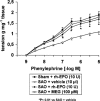Recombinant human erythropoietin inhibits iNOS activity and reverts vascular dysfunction in splanchnic artery occlusion shock
- PMID: 10385249
- PMCID: PMC1566014
- DOI: 10.1038/sj.bjp.0702521
Recombinant human erythropoietin inhibits iNOS activity and reverts vascular dysfunction in splanchnic artery occlusion shock
Abstract
1. We investigated the effects of recombinant human erythropoietin (rh-EPO) in splanchnic artery occlusion (SAO) shock. Sham operated animals were used as controls. Survival rate, mean arterial blood pressure (MAP), serum Tumor Necrosis Factor (TNF-alpha), plasma nitrite/nitrate concentrations, red blood cell (RBC) count, blood haemoglobin (Hb), the responsiveness of aortic rings to phenylephrine (PE, 1 nM-10 microM) and the activity of inducible nitric oxide synthase (iNOS) were studied. 2. SAO shocked rats had a decreased survival rate (0% at 4 h of reperfusion, while sham shocked rats survived more than 4 h), enhanced serum TNF-alpha concentrations, increased plasma nitrite/nitrate levels (60+/-9.5 microM; sham shocked rats= 2+/-0.4 microM), decreased MAP, unchanged RBC count and blood Hb and enhanced iNOS activity in the aorta. Moreover aortic rings from shocked rats showed a marked hyporeactivity to PE. 3. Rh-EPO (25, 50 and 100 U 100 g(-1), 5 min following the onset of reperfusion) increased survival rate (70% at 4 h of reperfusion with the highest dose), reduced plasma nitrite/nitrate concentrations (10.3+/-3.3 microM), increased MAP, did not change RBC count and blood Hb, and inhibited iNOS activity in thoracic aortae. Furthermore rh-EPO, either in vivo or in vitro (10 U for 1 h in the organ bath), restored to control values the hyporeactivity to PE. Finally rh-EPO inhibited the activity of iNOS in peritoneal macrophages activated with endotoxin. 4. Our data suggest that rh-EPO protects against SAO shock by inhibiting iNOS activity.
Figures





Similar articles
-
Effects of S-ethylisothiourea, a potent inhibitor of nitric oxide synthase, alone or in combination with a nitric oxide donor in splanchnic artery occlusion shock.Br J Pharmacol. 1996 Sep;119(1):23-8. doi: 10.1111/j.1476-5381.1996.tb15672.x. Br J Pharmacol. 1996. PMID: 8872352 Free PMC article.
-
Tacrolimus suppresses tumour necrosis factor-alpha and protects against splanchnic artery occlusion shock.Br J Pharmacol. 1999 May;127(2):498-504. doi: 10.1038/sj.bjp.0702528. Br J Pharmacol. 1999. PMID: 10385251 Free PMC article.
-
Protective effects of cyclosporin-A in splanchnic artery occlusion shock.Br J Pharmacol. 2000 May;130(2):339-44. doi: 10.1038/sj.bjp.0703310. Br J Pharmacol. 2000. PMID: 10807671 Free PMC article.
-
Participation of tumour necrosis factor and nitric oxide in the mediation of vascular dysfunction in splanchnic artery occlusion shock.Br J Pharmacol. 1994 Dec;113(4):1153-8. doi: 10.1111/j.1476-5381.1994.tb17118.x. Br J Pharmacol. 1994. PMID: 7889268 Free PMC article.
-
The effects of recombinant human granulocyte-colony stimulating factor on vascular dysfunction and splanchnic ischaemia-reperfusion injury.Br J Pharmacol. 1997 Jan;120(2):333-9. doi: 10.1038/sj.bjp.0700904. Br J Pharmacol. 1997. PMID: 9117128 Free PMC article.
Cited by
-
Erythropoietin reverts cognitive impairment and alters the oxidative parameters and energetic metabolism in sepsis animal model.J Neural Transm (Vienna). 2012 Nov;119(11):1267-74. doi: 10.1007/s00702-012-0774-2. Epub 2012 Feb 19. J Neural Transm (Vienna). 2012. PMID: 22350588
-
Erythropoietin improves neuronal proliferation in dentate gyrus of hippocampal formation in an animal model of Alzheimer's disease.Adv Biomed Res. 2012;1:50. doi: 10.4103/2277-9175.100157. Epub 2012 Aug 28. Adv Biomed Res. 2012. PMID: 23326781 Free PMC article.
-
Coping with hypoxemia: Could erythropoietin (EPO) be an adjuvant treatment of COVID-19?Respir Physiol Neurobiol. 2020 Aug;279:103476. doi: 10.1016/j.resp.2020.103476. Epub 2020 Jun 6. Respir Physiol Neurobiol. 2020. PMID: 32522574 Free PMC article. Review.
-
Asialoerythropoietin is a nonerythropoietic cytokine with broad neuroprotective activity in vivo.Proc Natl Acad Sci U S A. 2003 May 27;100(11):6741-6. doi: 10.1073/pnas.1031753100. Epub 2003 May 13. Proc Natl Acad Sci U S A. 2003. PMID: 12746497 Free PMC article.
-
Recombinant human erythropoietin protects the myocardium from ischemia-reperfusion injury and promotes beneficial remodeling.Proc Natl Acad Sci U S A. 2003 Apr 15;100(8):4802-6. doi: 10.1073/pnas.0630444100. Epub 2003 Mar 27. Proc Natl Acad Sci U S A. 2003. PMID: 12663857 Free PMC article.
References
-
- ACQUIT C.H.I., FERRAGU-HAGUET M., LEFEBVRE A., BERTHELOT J.M., PETERLONGO F., CASTAINGNE J.P. Recombinant erythropoietin and blood pressure. Lancet. 1987;2:1083. - PubMed
-
- BUEMI M., ALLEGRA A., SQUADRITO F., BUEMI A.L., LAGANA' A., ALOISI C., FRISINA N. Effects of intravenous administration of recombinant human erythropoietin in rats subjected to hemorrhagic shock. Nephron. 1993;65:440–443. - PubMed
-
- CAPUTI A.P., ROSSI F., CARNEY K., BREZENOFF H.E. Modulatory effect of brain acetylcholine on reflex-induced bradycardia and tachycardia in conscious rats. J. Pharmacol. Exp. Ther. 1980;215:309–316. - PubMed
-
- DING A.H., NATHAN C.F., STUEHR D.J. Release of reactive nitrogen intermediates from mouse peritoneal macrophages. J. Immunol. 1988;141:2407–2412. - PubMed
Publication types
MeSH terms
Substances
LinkOut - more resources
Full Text Sources
Other Literature Sources
Medical
Research Materials

